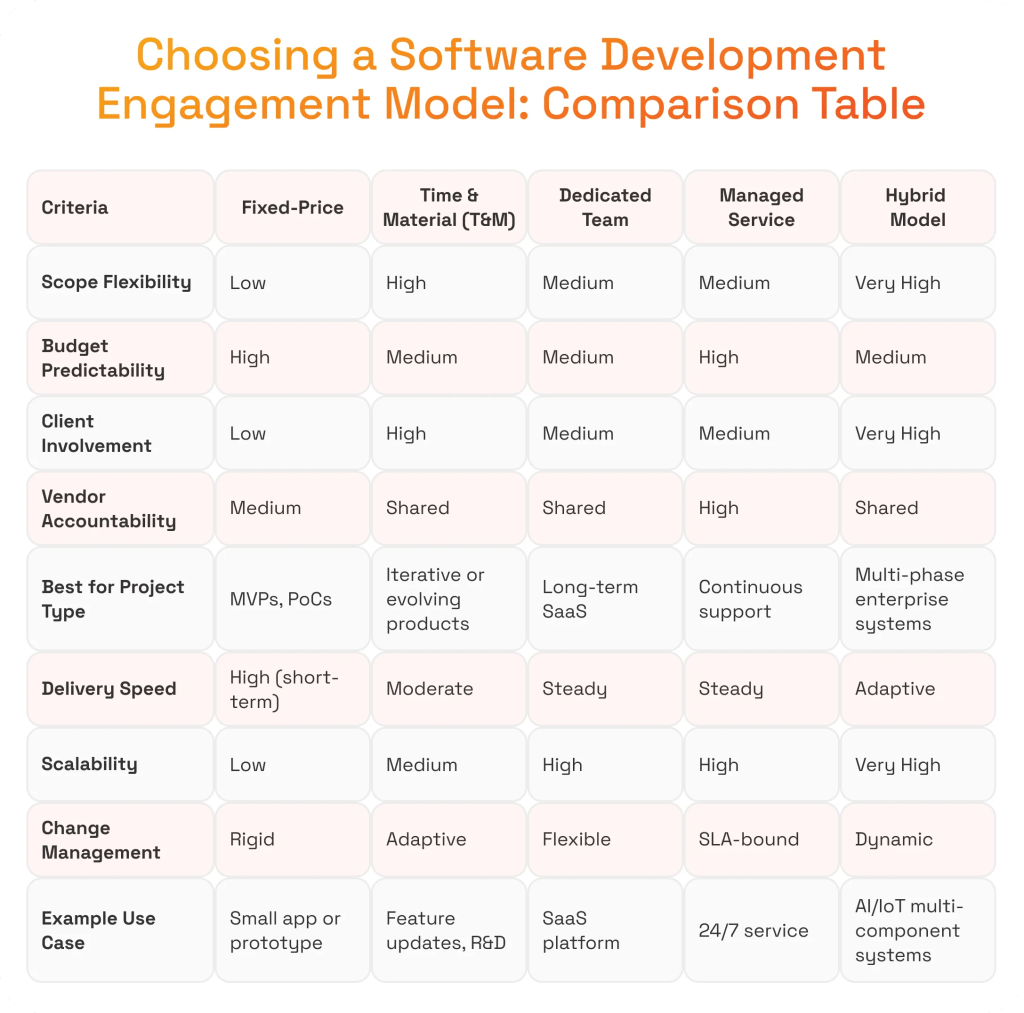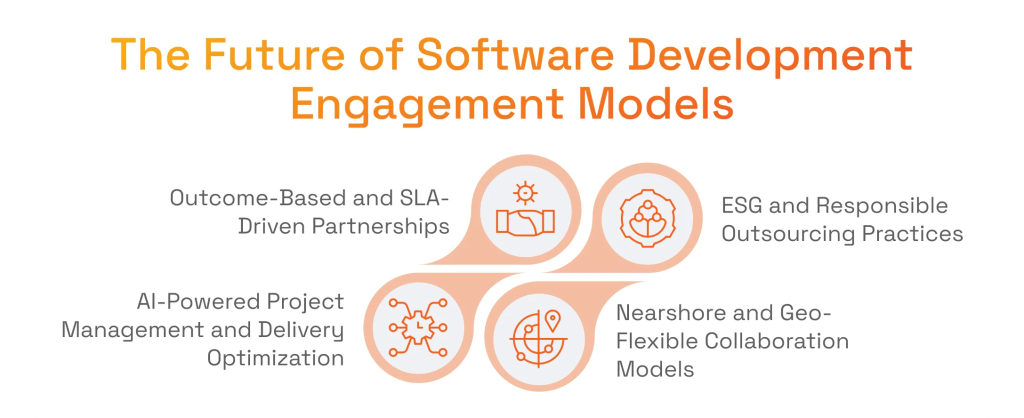Deloitte’s 2024 Global Outsourcing Survey found that over 76% of companies are outsourcing part of their IT work to external partners. As more companies rely on external IT partners, knowing how to align workflows and expectations between in-house and outsourced teams is critical to achieving project goals and avoiding inefficiencies, scope creep, or cost overruns. That’s where engagement models in software development step in to shape how teams actually work together.
This article examines client–technology partnership dynamics, challenges, evolution, and pros and cons of engagement models in the current software development outsourcing landscape.
What Are Engagement Models in Software Development?
An engagement model for software development defines the framework for collaboration between a client and a technology partner. It determines how responsibilities are distributed, who controls the workflow, and how costs are structured and managed throughout the project lifecycle.
McKinsey’s research shows that even well-strategized companies face a 30% performance gap due to flaws in their operating models, the very systems that define how work gets done. In software development, the engagement model plays a parallel role on a smaller scale, shaping collaboration and delivery between client and vendor. Selecting the right one is crucial to closing that gap.
Context drives everything in partnership selection. Since each project has its own objectives, constraints, and uncertainty factors, the engagement model must adapt accordingly. Since there is no single perfect model, customizations are essential for optimal results. Several key factors determine which engagement model will deliver the best results:
- Project complexity and clarity of requirements: Whether your product vision is well-defined or still taking shape influences how much structure, adaptability, and upfront planning your project needs.
- Desired flexibility and level of control: Some organizations prefer to stay closely involved in daily operations, while others are more comfortable delegating full ownership to their development partner.
- Available internal resources: The size, capacity, and expertise of your in-house team will shape how much external support or specialized skill you should bring in.
- Budget structure and delivery expectations: Your financial approach should align with the complexity and pace of your project to ensure predictability and efficiency.
Oleksandr Boiko
Delivery Director at SPD Technology
“Choosing one engagement model over another is always a trade-off. What you gain in predictability, you might lose in adaptability, and vice versa. The best model is the one that fits both your project’s goals and your team’s working style”.
Core Types of Software Development Engagement Models
There are several types of engagement models in the software industry, and each model defines how responsibility, control, and payment are distributed in a project. Every model fits different goals, budgets, and levels of client involvement.

Fixed-Price Model
The fixed-price IT engagement model is built around a predefined project scope, budget, and delivery timeline. Both parties agree on all requirements and deliverables before the software product development process begins. In this manner, the vendor and the client make the project scope stable and unlikely to change, which allows the vendor to plan and execute efficiently within fixed parameters.
Pros:
- Predictable cost and delivery timeline: The budget and deadlines are agreed upon upfront. This reduces the risk of unexpected expenses.
- Low client-side management involvement: With the scope and terms set in advance, the tech partner works on the project with minimal client input.
- Clearly defined milestones and deliverables: The project follows a structured plan with defined KPIs. This simplifies progress tracking.
- High accountability from the vendor: When vendors commit to a fixed price for defined deliverables, they’re naturally driven to meet deadlines and control costs.
Cons:
- Limited flexibility for scope changes: Any change to requirements results in contract revisions and additional costs.
- Risk of underestimating complex requirements during planning: If the initial plan misses requirements, the fixed scope makes changes later more difficult.
- May reduce innovation due to rigid contract terms: The fixed structure can limit experimentation due to fixed expected outcomes.
This is a rather rigid engagement model example, yet it has its perfect use cases. It is suitable for MVPs, proof-of-concept projects, and small mobile applications where requirements are stable and the risk of change is minimal. It also works well for clients with detailed technical documentation and short-term engagements that carry low uncertainty.
Time and Material (T&M) Model
T&M follows a pay-as-you-go approach where the client is billed for the actual time and resources spent on the project. Instead of locking all requirements and costs upfront, this project engagement model allows both parties to adjust priorities, scope, and team composition as the project evolves, needs change, and new trends appear.
Pros:
- High adaptability to evolving requirements: The project can adjust to new insights, feedback, or changing business goals without disrupting its progress.
- Transparent performance and cost tracking: Clients have full visibility into hours worked, deliverables completed, and costs used.
- Continuous development aligned with agile methodologies: T&M supports iterative delivery that ensures steady progress and demonstrates the value early.
- Flexible team composition and iterative delivery: The client can easily scale the team up or down and refine priorities.
Cons:
- Budget may fluctuate without proper monitoring: When there is no proper supervision and consistent budget tracking, cost overruns are inevitable.
- Requires client-side project oversight: The client must stay involved to manage priorities and ensure resources are used efficiently.
- Potential for scope creep if priorities are not well-managed: Without clear boundaries, additional tasks can accumulate, extending timelines and costs.
As the most flexible software development engagement model, it works best for long-term or R&D projects, dynamic environments where specifications evolve, and companies that follow agile or lean development approaches. It provides the room to pivot needed for experimentation, refinement, and adaptation.
Dedicated Development Team Model
When clients need software engineers, designers, and project managers who can work exclusively and full-time on their project, dedicated software development teams are the best option. Clients’ specific needs are the crucial factors in how the team will be formed and integrated into the client’s internal structure. Unlike short-term or fixed-scope collaborations, this model focuses on long-term partnership, ongoing product refinement, and strategic alliance.
Pros:
- Deep alignment with client’s business goals and processes: Dedicated teams fully immerse themselves in the client’s workflows, culture, and objectives.
- Access to specialized technical or domain expertise: Clients can build teams with niche skills or industry-specific knowledge that may be unavailable internally.
- High flexibility in scaling and prioritizing tasks: The client can adjust team size, reassign priorities, or pivot development direction.
- Promotes knowledge retention and long-term collaboration: Since the same experts remain on the project, they accumulate deep product knowledge, which enhances continuity and speeds up future development.
For example, our dedicated team’s consistent involvement in the vulnerability management platform development for our client fostered strong knowledge of the product domain, which helped manage evolving requirements, such as shifting from application-only scanning to full cloud-infrastructure support. As a result, we launched a complex platform with a robust set of features and scalability, built for long-term evolution.
Cons:
- Requires strong communication and project management: Effective dedicated development team management with clear processes, regular updates, and shared accountability between client and vendor is a must to keep the project running.
- Longer onboarding before full productivity is achieved: It is essential to give team members time to master the product, adopt internal tools, and absorb the company culture.
- Higher initial investment than short-term models: Establishing and maintaining a dedicated team requires greater upfront costs.
Enterprises developing long-term SaaS products or complex platforms, clients requiring continuous feature enhancements and technical support will find this delivery model ideal. This is also one of the most suitable engagement models for startups and other businesses without sufficient internal development resources since it provides sustained partnership, deep expertise, and the flexibility needed for ongoing growth.
Think the dedicated team model is the right fit for your project?
Discover how to hire a dedicated development team in our guide.
Managed Service Model
If the client needs the vendor to take full responsibility for the project’s delivery, quality, and performance, a managed outsourcing model is the best fit. Work is governed by predefined service level agreements (SLAs) for product development that establish expectations for timelines, outcomes, and performance metrics. Responsibilities are evenly divided and agreed upon as well: typically, vendors manage technical execution, and clients drive strategic direction and business goals.
Pros:
- End-to-end delivery ownership: The vendor handles every aspect of the process for consistent execution and accountability.
- Predictable service quality through SLAs: Defined SLAs set quantitative and qualitative performance standards that bring reliability throughout the collaboration.
- Ideal for ongoing product support, maintenance, and evolution: This model provides stability and continuity for products that require long-term attention and updates.
- Allows internal teams to focus on strategic initiatives: With the vendor handling operational tasks, in-house teams can focus on creative work.
Cons:
- Less visibility into day-to-day technical operations: Since the vendor runs the process independently, the client has limited insight into daily workflows.
- Dependency on vendor reliability and internal processes: For the client to be confident in the project’s success, the tech company must demonstrate a commitment to clear communication, consistent work, and high-quality results.
- Limited agility for mid-project adjustments: SLAs and predefined scopes can make it challenging to pivot or introduce changes.
For businesses committed to steady product evolution, service reliability, and efficiency gains without extra managerial effort, this IT engagement model ensures a lasting and performance-based collaboration.
Hybrid / Customized Software Development Engagement Model
The customized partnership combines elements of T&M, dedicated teams, and managed services. Working according to this model allows for delivering a solution tailored to specific project requirements. Considered one of the most flexible engagement models, it allows organizations to adapt their approach to software product development services across different project stages to align delivery methods with changing priorities, timelines, and budgets.
Pros:
- High flexibility and scalability: The model adapts easily to project evolution, allowing teams to expand, contract, or shift focus.
- Optimized cost efficiency through model blending: Thanks to combining pricing and management structures, clients can control expenses.
- Allows phase-based delivery and resource reallocation: Different stages of development can operate under the most effective engagement type.
- Reduces long-term dependency on a single vendor: Blended models combine different areas of expertise.
Cons:
- Requires clear governance and role distribution: Successful coordination depends on well-defined responsibilities and communication channels between all stakeholders.
- Complex management structure if coordination is weak: Without strong oversight, hybrid setups may create confusion or inefficiencies between teams operating under different models.
If enterprises are running multiple development phases or products or operating intricate platforms including AI, IoT, and cloud systems, this model can be the best option. It also suits organizations that are focused on maintaining innovation without losing budget discipline.
Choosing a Software Development Engagement Model: Comparison Table
To help visualize the differences between the main engagement models in software development, the following table compares them across key criteria.

Figured out which cooperation model fits your project?
Discover the next step in our guide on how to outsource app development.
Emerging Trends in Software Development Engagement Models
New challenges and opportunities constantly reshape how companies work with technology partners. Therefore, keeping pace with emerging trends in software development engagement models allows organizations to collaborate more effectively, reduce risks, stay agile, and achieve a smarter balance between innovation and cost.
Security and Compliance as Strategic Priorities
Security and compliance have evolved from technical requirements into core imperatives within IT engagement models. Vendors increasingly integrate DevSecOps practices, advanced data encryption, and GDPR or SOC 2 compliance directly into their workflows and contracts. At the same time, clients are now better aware of measures required for secure development practices. As a result, they now demand proactive security audits, encrypted CI/CD pipelines, and verified compliance guarantees before deployment.
All that means that partnership frameworks now emphasize shared accountability, where both the client and vendor are equally responsible for safeguarding sensitive information and maintaining compliance across every stage of the development lifecycle.
UX-Driven and Microservices-Oriented Delivery
Every modern engagement model for software development increasingly revolves around UX and microservices-based architecture. Outsourced development teams are shifting from monolithic builds to modular, service-oriented delivery structures because they enhance scalability, maintainability, and speed. This evolution allows businesses to iterate quickly, deploy updates continuously, and ensure consistent UX across web, iOS, and Android platforms.
UX-centric thinking ensures that products meet real-world needs, while microservices enable agile development cycles and reduced downtime. It means that these trends make software outsourcing models design-focused and capable of supporting rapid innovation across diverse digital ecosystems.
Specialization in Emerging Technologies
Technologies evolve fast, and in-house teams of domain-specific businesses do not have enough time to keep up. This is why organizations need to outsource AI/ML development expertise, DevOps expertise as well as engage more AR/VR, IoT, and blockchain professionals to their projects.
Software development engagement models must be adapted to be ready for faster adoption of advanced tools, reduced learning curves, and greater competitive advantage. For enterprises pursuing digital transformation, such partnerships deliver strategic insight and technical leadership. Vendors that cultivate expertise in emerging fields position themselves as long-term innovation partners.
Rise of Hybrid and Flexible Engagement Models
The demand for adaptability and cost optimization has led to the rise of hybrid frameworks that blend elements of different types of engagement models in IT. In this agile way, businesses get the possibility to tailor collaboration to different project phases. For example, they can use fixed pricing for discovery, T&M for development, and managed services for ongoing maintenance.
Hybrid models used in custom software development services support scalability, cost control, and faster delivery in volatile markets. The combination of the strengths of multiple cooperation models makes hybrid frameworks perfect for organizations that want to align technology partnerships with strategic objectives.
Oleksandr Boiko
Delivery Director at SPD Technology
“More trends will emerge. To thrive, organizations must remain agile and ready to adjust their collaboration models, as this adaptability is the key to consistent value delivery and strategic success”.
The Future of Software Development Engagement Models
According to Deloitte’s 2024 Global Outsourcing Survey, 80% of executives plan to maintain or increase outsourcing investments. This indicates that software development engagement models are becoming, and will remain, central to how organizations access talent, optimize expenses, and grow. Yet, they will evolve along with outsourcing needs.

Outcome-Based and SLA-Driven Partnerships
The shift from traditional time-and-effort pricing to outcome-based contracts will be inevitable for engagement models in software development. This transition will place even greater emphasis on measurable business results and on the success of the product. Instead of billing for hours worked, vendors will be evaluated on performance indicators such as product quality, time-to-market, user adoption, and ROI.
KPIs and SLAs will become the foundation of these partnerships, as they will be able to ensure accountability and alignment with business end goals. Even the process of writing a software development RFP will evolve: organizations will increasingly define success criteria, desired outcomes, and performance metrics rather than simply listing technical requirements. Owing to this, organizations will get the opportunity to improve project predictability, quality, and long-term value for both parties.
AI-Powered Project Management and Delivery Optimization
Companies adopting automation and machine learning in their IT partnership strategies and workflows will achieve smoother project management and clearer communication. Automated systems will handle repetitive administrative tasks and, thus, reduce manual processes and bridge information gaps. Machine learning models, in turn, will analyze project data to identify trends and anticipate potential obstacles before they escalate.
Another benefit will be AI-driven dashboards that predict resource needs and flag risks. Its use will reduce human error, improve cost allocation, enhance reporting, and accelerate delivery. In other words, project management within the framework of vendor cooperation will become a self-optimizing system that continuously learns from performance data to enable high-quality adjustments.
Nearshore and Geo-Flexible Collaboration Models
Global software development partnerships are entering a new phase where nearshoring, offshoring, and geo-flexibility are key differentiators. Nearshore models (offer similar time zones, cultural alignment, and strong technical expertise) will continue to rise as businesses seek balance between quality and cost. At the same time, offshore software development remains a strong option for organizations looking to scale quickly and access specialized expertise.
What’s more, remote-first operations are evolving into structured hybrid collaboration frameworks, as they blend distributed software development teams with localized management to ensure seamless communication and productivity. This method enables companies to tap into global talent, maintain agility, build long-term partnerships, and overcome geographical barriers without the loss of productivity.
ESG and Responsible Outsourcing Practices
As sustainability and ethics take center stage in corporate strategy, Environmental, Social, and Governance (ESG) principles will increasingly shape any software development engagement model. Organizations will evaluate vendors on environmental impact, ethical labor practices, and transparency. Responsible outsourcing, which pays attention to ensuring fair wages, inclusive workplaces, and low-carbon operations, will become a key competitive differentiator.
Because of this shift, the process of finding a trusted custom, mobile, or web development service provider will extend beyond technical nuances to include ESG alignment and long-term responsibility. Future partnership models will integrate ESG criteria into procurement and collaboration decisions to position socially responsible vendors as preferred partners for digital transformation.
Don’t know who your ideal partner is?
Find one on our list of the most prominent product development companies.
Conclusion: Flexibility and Trust Define Modern Software Partnerships
As outsourcing continues to expand its boundaries, the crucial role of engagement models for digital transformation becomes increasingly evident. They dictate how the cooperation between the vendor and the client is established, how both partners communicate, approach time and budget allocation, implement visions, and push businesses forward.
There are five main software vendor partnership models: fixed-price, time and materials, dedicated team, managed services, and hybrid. Each of these models serves different client-vendor relationship styles. To choose the option that best fits the project, it is necessary to pay particular attention to the scope, budget, as well as level of involvement and accountability, among other criteria.
No less important is learning about and implementing emerging trends that shape these models. Some of the most important ones are prioritizing security and compliance, emphasizing UX, adopting microservices and emerging technologies, and opting for hybrid cooperation frameworks.
With outsourcing expected to grow even further, organizations should also keep in mind emerging priorities such as outcome-based models, AI and ML adoption, nearshoring strategies, and ESG-driven environmental responsibility. This will show that the vendor is committed to growth and quality. We can help you build your project responsibly and in line with the collaboration model that best fits your needs. Reach out to start your tailored development journey.
FAQ
Can the Engagement Model Be Changed During the Project Lifecycle?
Yes, the cooperation model can be changed during the project lifecycle, though it requires careful planning. Adjustments often happen when project scope, priorities, or resources shift. A structured transition that covers budget, roles, and deliverables will ensure continuity and minimize risks without sacrificing technical needs.
How Does the Choice of Engagement Model Affect Budget, Schedule, and Quality?
The delivery model the client and the vendor select shapes every critical project dimension. In fact, it can be a cornerstone that defines how the project will flow.
- A fixed-price model offers cost predictability but limits flexibility for changes.
- Time and material allows adaptability and iterative improvement, but can increase spending if not managed well.
- A dedicated team ensures consistent quality and long-term alignment, but requires ongoing investment.
- Managed services deliver stability and performance through SLAs, while hybrid models balance cost control with scalability.
So, selecting the right model defines how resources are allocated, risks are managed, and quality standards are upheld.
How Does the Choice of Engagement Model Impact Scalability When a Project Grows Rapidly?
The choice of a client-vendor partnership model determines how easily the team can scale a project. Dedicated teams and T&M offer agility and flexibility in terms of team composition and scope. Fixed-price contracts are less adaptable, which can lead to the need to renegotiate for major changes. Hybrid models provide balance because they enable businesses to scale resources efficiently while maintaining control, quality, and budget alignment.

